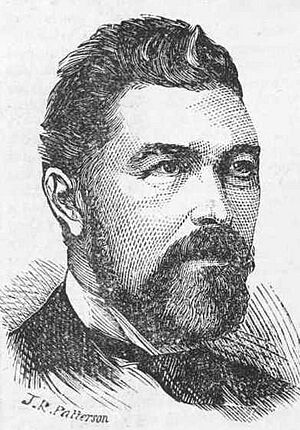James Patterson (Australian politician) facts for kids
Quick facts for kids
Sir James Patterson
|
|
|---|---|
 |
|
| 17th Premier of Victoria | |
| In office 23 January 1893 – 27 September 1894 |
|
| Preceded by | William Shiels |
| Succeeded by | George Turner |
| Constituency | Castlemaine |
| Personal details | |
| Born | 18 November 1833 Alnwick, Northumberland, England |
| Died | 30 October 1895 (aged 61) Murrumbeena, Victoria, Australia |
| Spouse | Anna Merrick Walton |
Sir James Brown Patterson (1833–1895) was an important Australian politician. He served as the leader of the government in Victoria, known as the Premier, from 1893 to 1894.
Contents
Early Life and Move to Australia
James Patterson was born in England in 1833. His family lived in a place called Alnwick, in Northumberland.
When he was about 19 years old, in 1852, James moved to Victoria, Australia. He hoped to find gold there, like many others during the gold rush.
He spent a few years working as a gold digger. Then, he tried farming for four years. Later, he settled in a town called Chewton.
In Chewton, James started his own business as a butcher. He later also worked in real estate, buying and selling land. He was even the Mayor of Chewton for four years.
In 1870, he was elected to the Victorian Legislative Assembly. This meant he became a member of the local parliament for the area of Castlemaine.
Political Career
James Patterson was known as a moderate conservative politician. This means he generally supported traditional ideas and careful changes.
He worked in the governments led by Graham Berry, a liberal leader. From 1875, he was a "commissioner for public works." This role meant he helped manage government building projects.
From 1877 to 1880, he also held the title of Vice-President of the Board of Land and Works. This board managed public land and projects. He was also the Postmaster-General from 1878 to 1880, in charge of postal services.
After 1881, Patterson joined the "opposition." This means his political group was not in power. They worked to challenge the government. He later became a "commissioner for trade and customs" from 1889 to 1890. This was in the government led by Duncan Gillies.
Becoming Premier
Around 1891, Victoria faced a serious economic problem called a depression. This happened after a period of fast growth called the "Land Boom" ended. Many people lost money and jobs.
James Patterson became a strong voice for businesses and middle-class people. They did not want the government to raise taxes during this tough time.
In January 1893, Patterson led a successful "no-confidence motion." This vote showed that most politicians no longer supported the government led by William Shiels. Because of this, James Patterson became the new Premier of Victoria.
Leading Victoria
Patterson's government faced big challenges. In April 1893, several banks in Victoria started to fail. People rushed to withdraw their money.
To stop the panic, Patterson declared a "bank holiday" from May 1 to May 5, 1893. This meant banks were closed, so people could not take out their money. There were protests outside the closed banks. People lost trust in the colony's financial system.
Later that year, Patterson realized that raising taxes might be necessary after all. The opposition party supported this idea. However, his own conservative supporters disagreed. He had to drop the idea, which left his government without a clear plan.
Later Life and Legacy
The government struggled until August 1894. Patterson lost another "confidence vote" in the parliament.
After this, new elections were held. Patterson's conservative party lost badly to the protectionist party led by George Turner. George Turner then became the new Premier.
Patterson returned to being a member of the opposition. In 1894, he was honored with the title K.C.M.G. This means he became a Knight Commander of the Order of St Michael and St George.
Sir James Patterson was still a member of parliament when he passed away. He died on October 30, 1895, from influenza in Murrumbeena, Victoria.
An old portrait of Patterson from 1893 hangs in the Victorian Parliament House. You can see it online here: 1893 portrait of Patterson.
Some places in Victoria are thought to be named after him. These include Patterson Lakes and river, Patterson Road, and the Patterson railway station.

